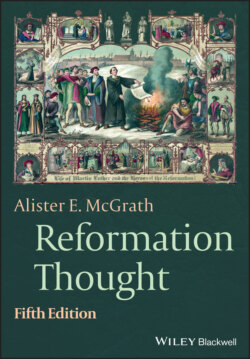Читать книгу Reformation Thought - Alister E. McGrath - Страница 20
The Need for Doctrinal Reform
ОглавлениеYet there were others who added another demand to this list of long-overdue reforms of morals and practice – a reformation of Christian doctrine. The core religious ideas of the church seemed to have become muddled and unfocused. Many Catholic writers agreed. One of the most interesting developments at the Council of Trent, which set in place the reforming program of the “Catholic Reformation,” was its call for the simplification of the vocabulary and conceptualities of Christian doctrine. There was a concern that scholastic theology, predominant during the Middle Ages, was inaccessible to ordinary people. It was important to use simpler and clearer language to express core Christian beliefs. Trent also appreciated the importance of religious education, and initiated a process of catechization, in which ordinary believers would be helped to grasp the basic themes of the Christian faith.
Yet this demand for the simplification of theological language was not accompanied by any program of review or revision of the prevailing doctrinal consensus of the church. Many Italian bishops at the Council of Trent (Figure 1.2), perhaps influenced by the general dislike of many Renaissance humanists for the technicalities of theology, felt that there was no need for such a review. Reform was restricted to institutional, moral, and pastoral matters – all of which mattered profoundly, of course, but did not engage the concerns expressed by writers such as Luther and Calvin.
Figure 1.2 The 23rd Session of the Council of Trent, 1563. Bridgeman XIR 33245. The Council of Trent, 4th December 1563 (oil on canvas), Italian School (sixteenth century), Louvre, Paris, France. Formerly attributed to Titian (1488–1576).
To critical observers such as Martin Luther at Wittenberg and John Calvin at Geneva, the medieval church seemed to have lost sight of its intellectual and spiritual heritage. It was time to reclaim the ideas of the Golden Age of the Christian church. The sad state of the church in the early sixteenth century was simply a symptom of a more radical disease – a deviation from the distinctive ideas of the Christian faith, a loss of intellectual identity, a failure to grasp what Christianity really was. Christianity could not be reformed without an understanding of what Christianity was actually meant to be. For Luther, in particular, the morbidity of the late Renaissance church was simply the latest stage in a gradual process of degeneration which had been going on since the early Middle Ages – the corruption of Christian doctrine and ethics.
Thinkers such as Luther and Calvin held that the core ideas that lay at the heart of Christian faith and practice had been obscured, if not undermined, through a series of developments in the Middle Ages. According to these and other reformers of that age, it was time to reverse these changes, to undo the work of the Middle Ages, in order to return to a purer, fresher version of Christianity which beckoned to them across the centuries. The reformers echoed the cry of the humanists: “back to the fountainhead (ad fontes),” a call to return to or learn from the Golden Age of the church, in order to reclaim its freshness, purity, and vitality in the midst of a period of stagnation and corruption.
